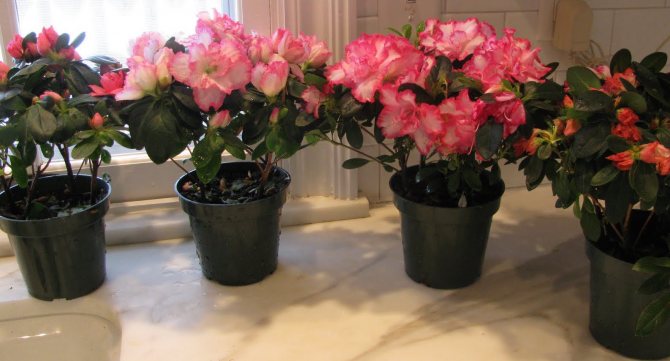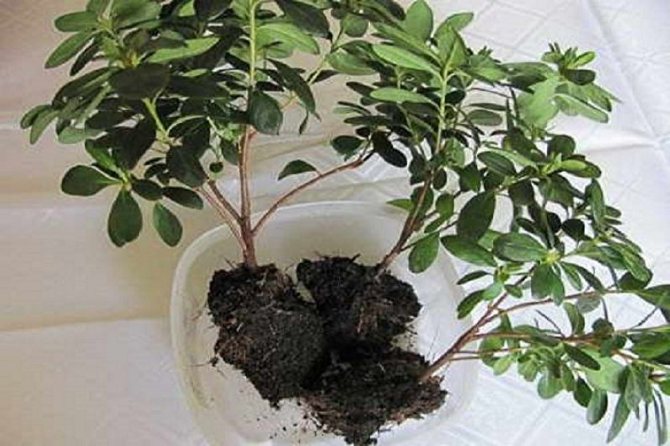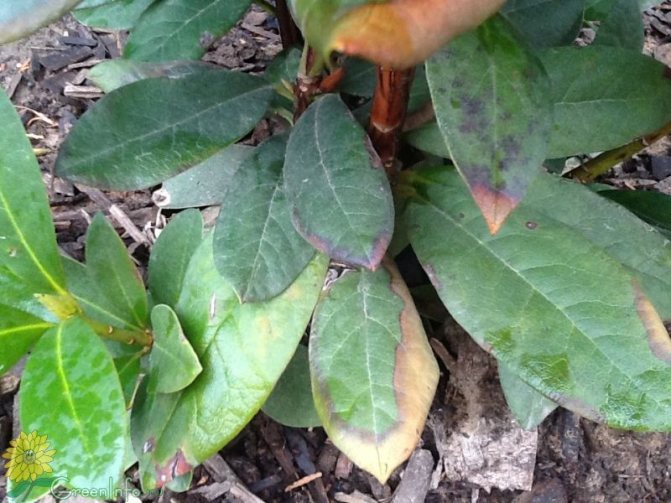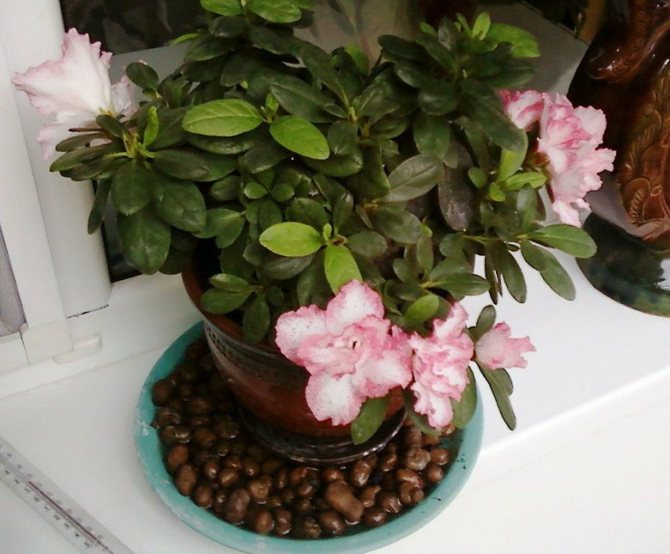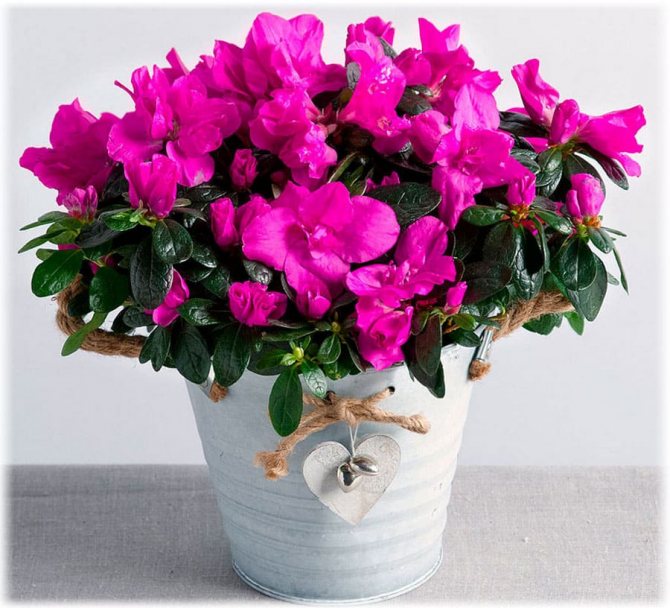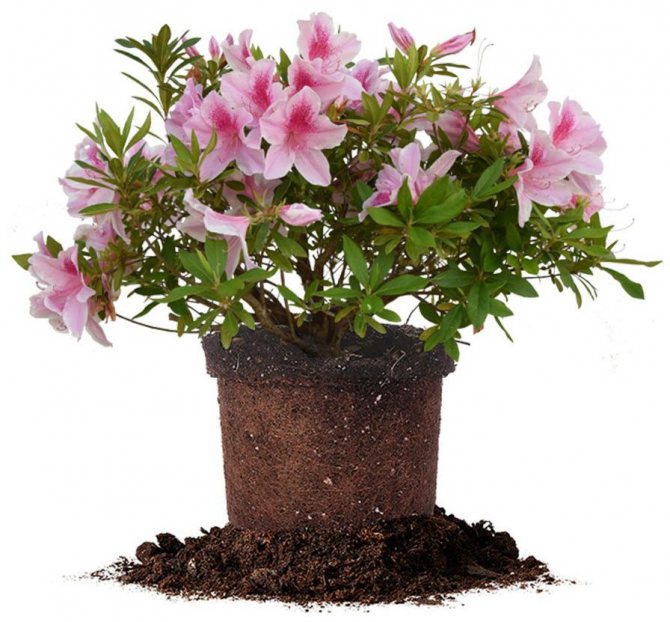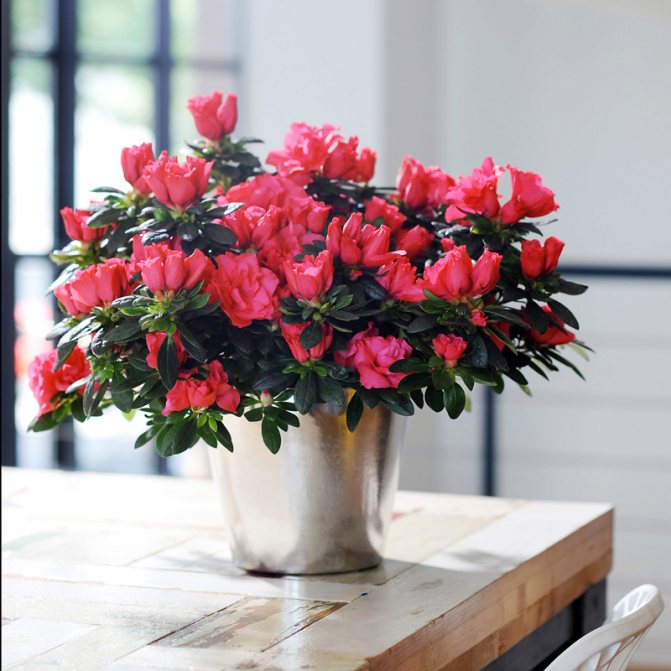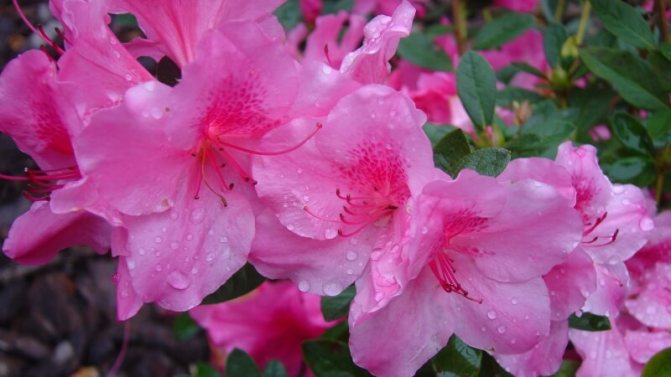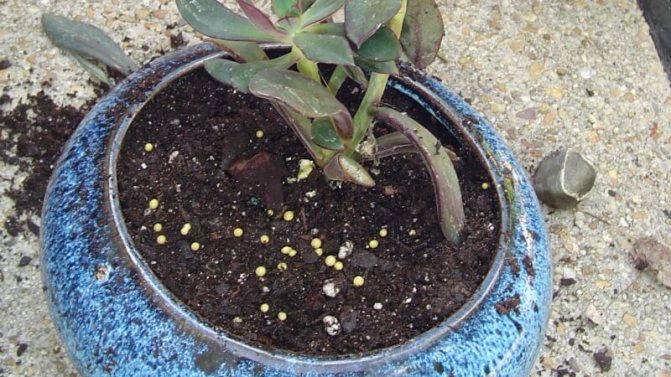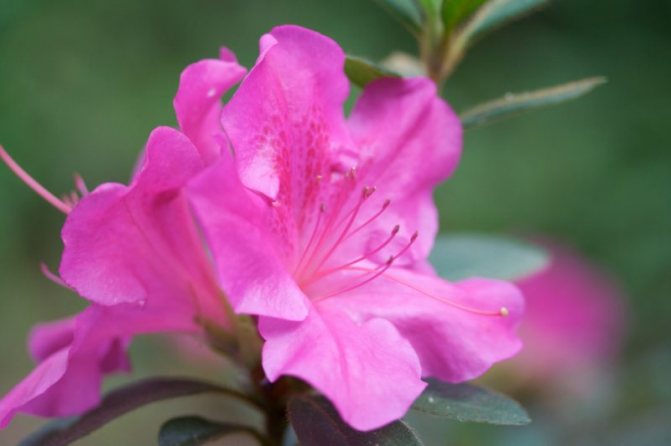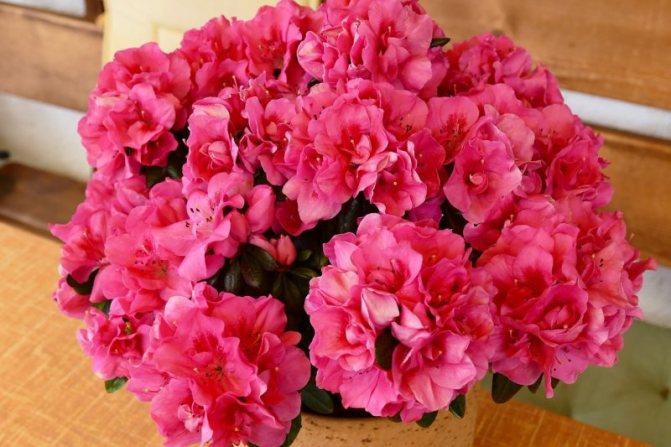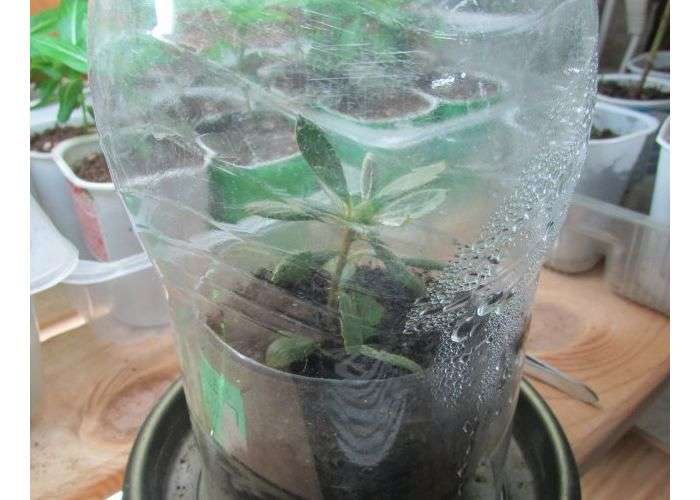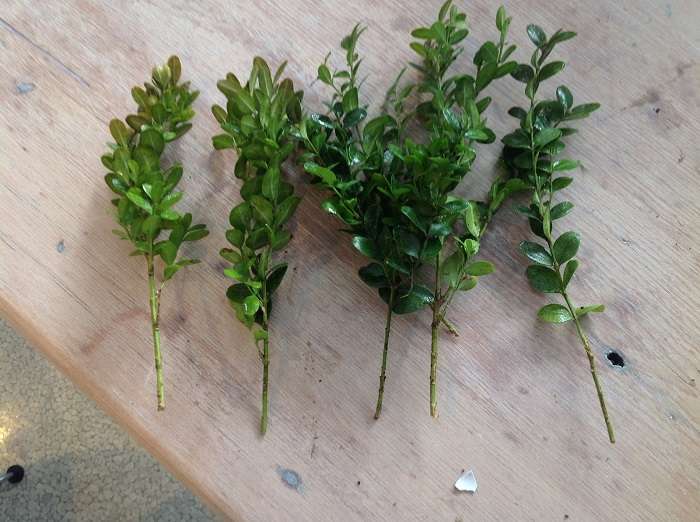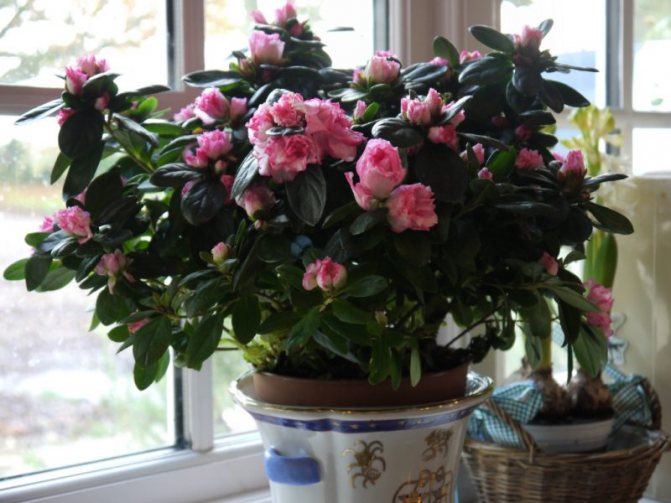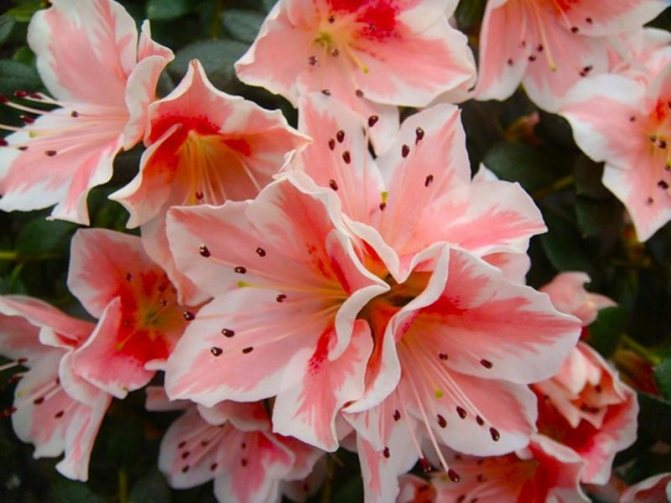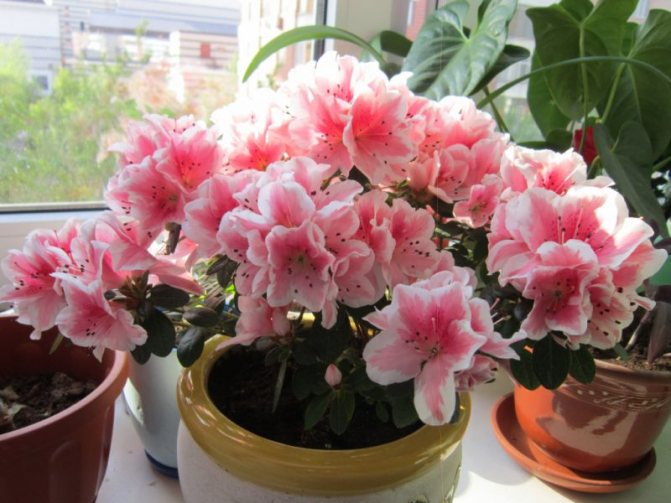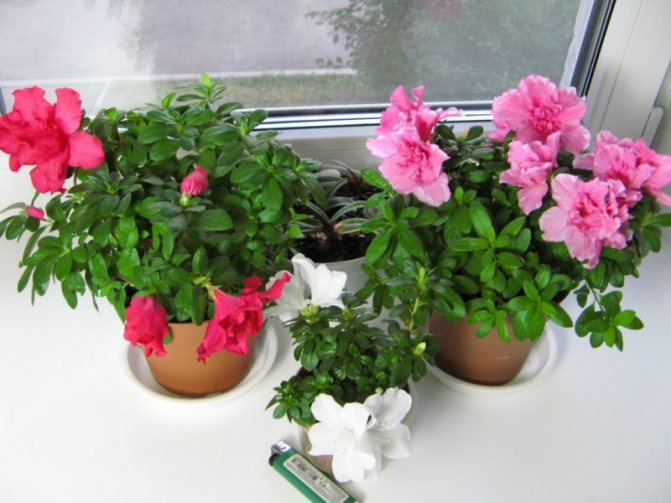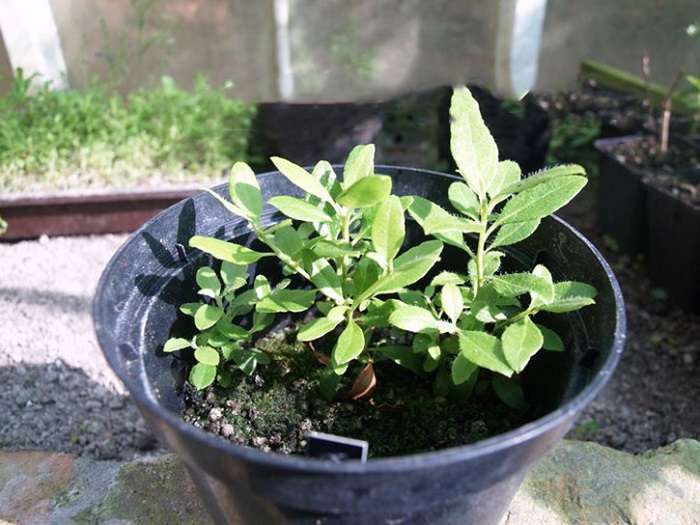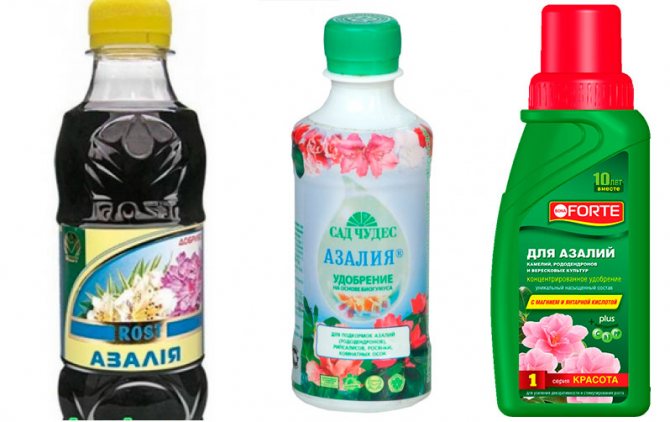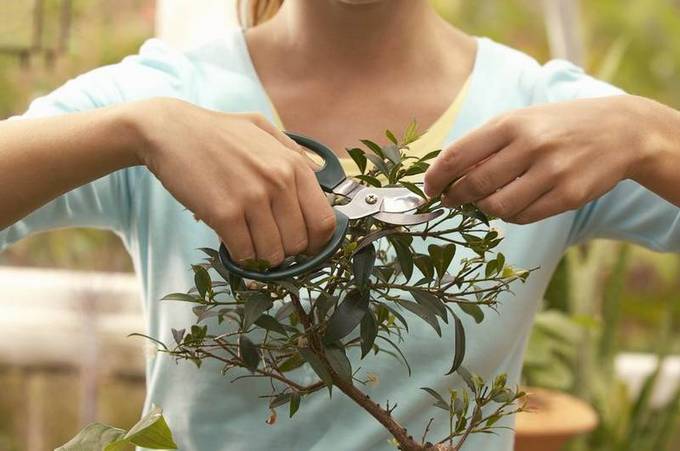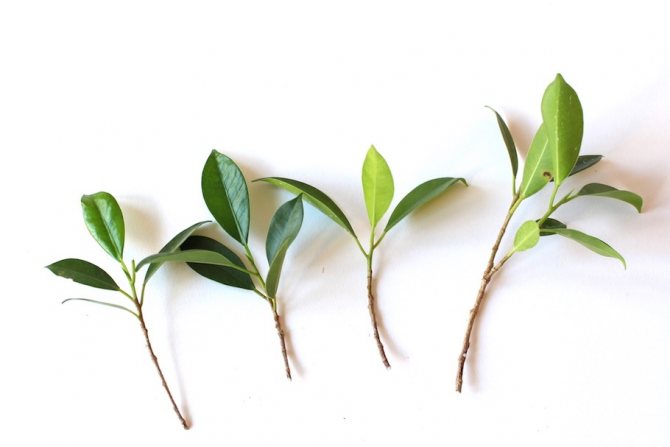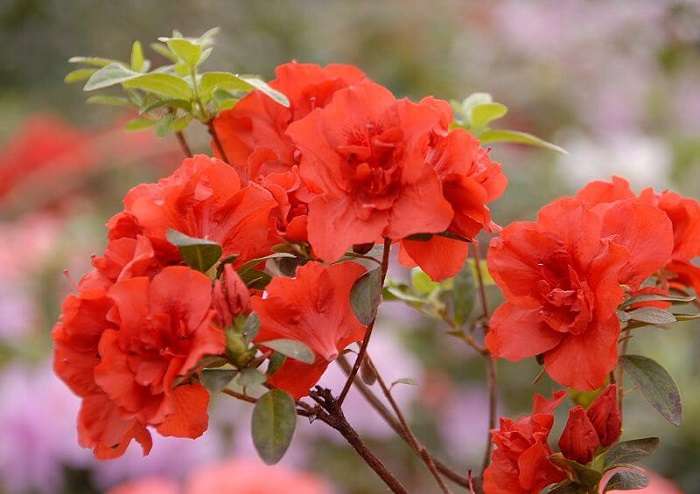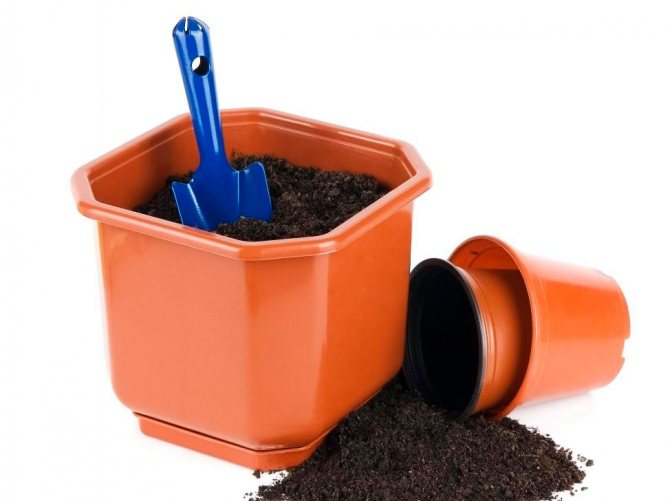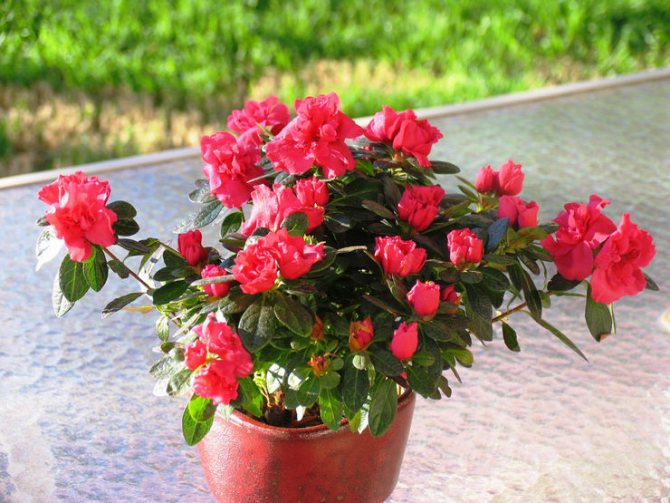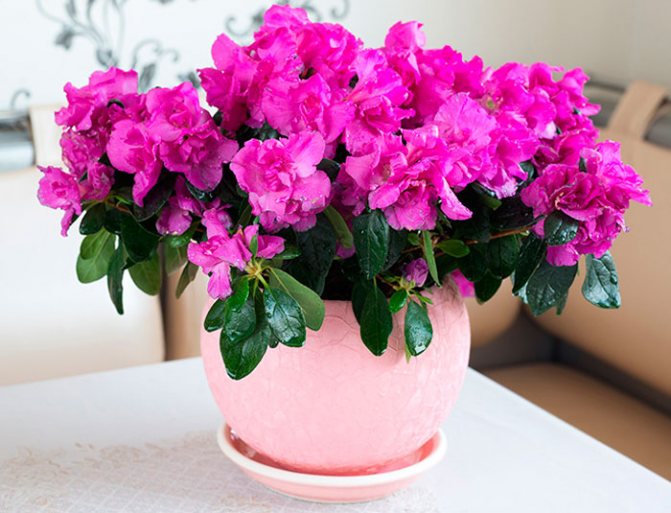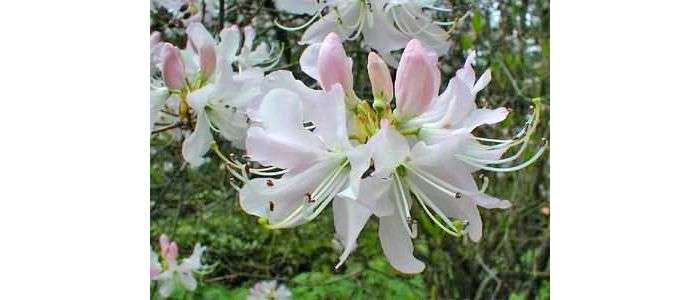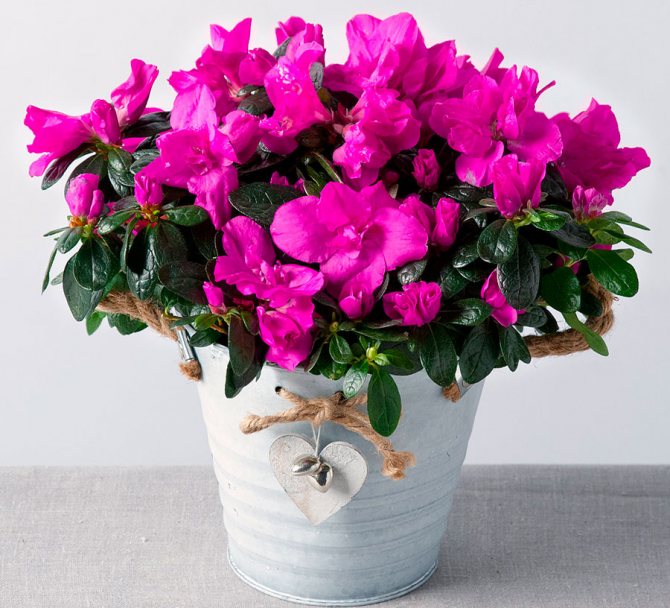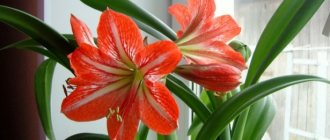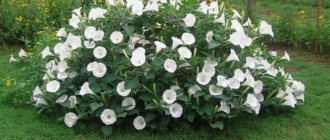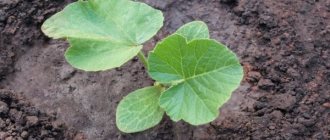From the history of the azalea
Azalea was discovered in the late eighteenth and early nineteenth centuries in England. During his travels, the Dutch scientist Brainius discovered a plant that amazed him with its beauty, the shrub covered with fabulously beautiful flowers left him no choice. He brought it to his homeland, but after a short period the plant did not take root and died. After some time, another traveler and scientist Conners made an attempt to tame the azalea, but also unsuccessfully, the bush could not stand the move and also died.
Only at the very beginning of the nineteenth century, Captain Wellbank brought from India the first specimen of an azalea, which he managed to take root. After that, this specimen became the ancestor of a great variety of different hybrids and varieties. The work done by botanical scientists cannot be overestimated, because their long-term selection work contributed to the birth of this beautiful evergreen shrub, which pleases us with its lush flowering at a time when most of the plants are in the "hibernation" period.
Temperature regime
Azalea, due to its northern origin, is a very capricious plant. It is not surprising that after buying an azalea from a flower shop, you bring it home, and after a few weeks of flowering, the shrub will shed its leaves and begin to dry. Therefore, it is important to immediately create favorable growth conditions for the azalea, and the temperature regime plays an important role in this. Azalea care will not take much of your time if you know some of its features. Azalea prefers to grow in cool rooms with air temperatures from +10 to +15 degrees. The maximum allowable temperature is +18 degrees. Of course, it is difficult to create such a temperature at home, but here some tricks will help us.
- A pot of shrubs around the perimeter can be overlaid with ice cubes.
- Water and spray periodically with cool distilled or boiled water.
In winter, azalea feels great on closed loggias until the temperature there drops below +5 degrees. It is during this period from October to December that the azalea forms flower buds.. The best location of the flower in winter can be considered the windows of the house, directed to the north and west. During the azalea flowering period, the air temperature should not be more than 16-17 degrees, because this is the optimal temperature to stimulate flowering.
How to transplant azalea after purchase
When transplanting, special attention should be paid to the choice of a pot. It should be about five centimeters higher than the previous one. You can choose both plastic and clay containers.
Soil preparation
Zamioculcas - home transplant after purchase
The most suitable soil is a special mixture purchased from a store. You need to add a baking powder (sphagnum or river sand) to it.
Preparing the soil for an azalea yourself is not easy, but if you try, you can do it. An example of such a mix: take one part of peat, two parts of rotted needles and add a little river sand there.
Transfer
The step-by-step transplant process consists of the following stages:
- Remove the azalea from the pot.
- After examining the root system, you can see a dense clod of earth with many small roots.A large bush must be divided, this is done by cutting the earthen coma into pieces. Each layer needs its own pot
- Cut the ground at the bottom and sides, make cuts around the entire circumference.
- Make a solution of a special mixture of Kornevin and lower the roots for half an hour in a container with this liquid.
- Line the bottom of the pot with drainage. Next, add a layer of river sand and moss.
- Sprinkle with Trichodermine, necessary to prevent fungal and putrefactive bacteria.
- Spread a layer of potting mix evenly on the surface of the pot.
- Remove the azalea from the water and wait for the liquid to drain.
- Place the bush in the center of the pot.
- Gently fill the soil without touching the root collar of the bush. You cannot deeply deepen it.
- Lightly compact the soil around the root.
At the end of the transplant, lightly moisten the substrate with the solution remaining from soaking the root system.
Attention! Excessive flooding of the flower after transplanting is not allowed. The earth dries out faster than the roots, so the latter can rot.
Lighting azalea
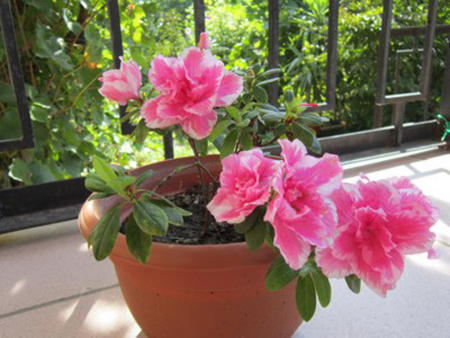
Azaleas love bright lighting besides direct sunlight. Direct sunlight can burn the leaves in the form of dry tips. Shrubs of this type are more suitable for window sills facing the east, west and north sides. If you want to position the azalea on the sill of the south window, then cover it with a slightly matte sheet of plastic, thereby creating diffused light. In winter, azalea can suffer from a lack of light. To increase the daylight hours for azaleas, you can install additional lighting in the form of lamps with fluorescent lamps.
How to water properly
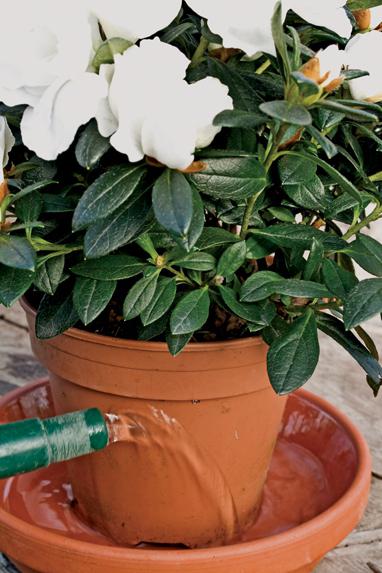

Watering the azalea
As with any plant, water is a very important detail that saves them from wilting.
For home flowers, the following are of great importance:
- Water quality;
- Temperature level;
- Frequency and abundance of watering.
Never water your azalea with cold or even ice water! An unexpected change in temperature can be a real stress for the flower.
Up to the point that this can serve as a kind of signal for the plant that autumn has already come. And then the azalea will drop both flowers and leaves. Ideal for azaleas will be water at the same temperature as the flower itself.
Only soft water is needed. It will be better to boil the water first, then let it cool. It is also important to water only the upper layers of water in the container, trying to prevent sediment from getting into the ground.
If you water the soil with plain water, the acidic soil will become alkaline, because it contains a lot of mineral salts. After boiling, they become the aforementioned sediment. To acidify the soil a little more, you can add three drops of juice to a liter of water.
If you bury the azalea in the street soil for the summer period, the rain will only benefit it.
This plant will not be able to withstand drought. If you notice that the leaves or flowers have begun to drop, this is the first signal that the flower must be watered immediately. Nothing like this should be allowed. It is better to keep the moisture content of the earthen mixture normal. Excessive fluid can also damage fragile roots, and they can start to rot.
This plant loves water, so it is good if the watering is plentiful. It should usually be watered every other day. But if the air in the room where you placed it is dry (this happens especially often in winter), then it will be better to water every day.
Water the plant from above, and it is better to drain the excess water from the pan. As you probably already understood, you need to monitor the soil moisture so that the leaves do not begin to fall off.
Watering the azalea
Azalea is a plant brought to us from a humid climate, so its soil should be slightly moist, but not wet.Watering an azalea comes down to a simple rule: the lower the temperature in the room, the fewer times you need to water the azalea, the higher the temperature, the more times. If it turns out that the soil is completely dry, place the pot in a container of water for no more than 4 hours. After such a procedure, you can return to normal watering of the azalea only after 3 days.
In sunny and hot weather, the azalea should be periodically sprayed and watered twice a day. When watering, it is categorically not recommended to use tap water, it is best to boil it or, in extreme cases, let it settle. The most favorable for watering azaleas is rainwater (melt) or distilled. To maintain the acidity level of the soil, it is recommended to water the azalea with a solution of citric acid, based on their calculation: 1 teaspoon of citric acid in a two-liter jar. Excess water from the pot must be removed, otherwise the root system may rot.
Pot and soil
The primer is recommended to be purchased at a specialized center. The composition should be designed specifically for this type of color. In the absence of such a substrate, you can use a mixture of needles and peat or heather soil.
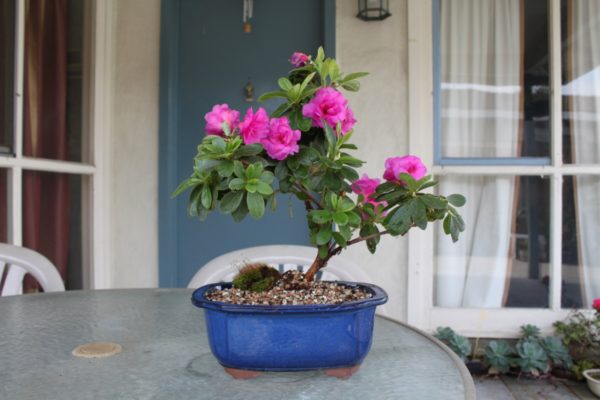

Pots are chosen not very deep, in the form of a bowl, since the roots of the plant are at the surface. Both clay and plastic containers are suitable for transplanting.
Important!
The size of the pot should be larger than the previous one. In order to prevent decay of the roots, a drainage layer must be placed on the bottom of the container.
You need to transplant the bush very carefully so as not to damage the rhizome. But at the same time, if possible, remove all the old soil.
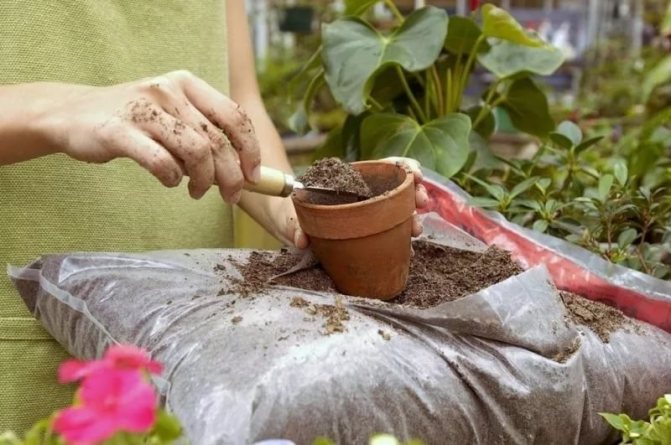

Azalea feeding
Azaleas are fed every two weeks with mineral fertilizers. During the period of bud formation, it is recommended to use Superphosphate at a concentration of 15g per 10 liters of water. The ideal option when feeding a flower is to use a special fertilizer "Azalea", which is sold in flower shops. There are also a number of fertilizers that promote the growth and flowering of azaleas. During the period of bud formation, to accelerate flowering, a fertilizer containing large amounts of phosphorus and potassium is used - "Uniflor-Bud" and "Kemira-Lux".
After flowering during the growing season, use a fertilizer containing nitrogen - "Uniflor-micro". A good tool for feeding, stimulating flowering, root growth will be "Zircon" - a growth stimulator based on plant materials. Sold in all flower shops in plastic containers. The drug is highly economical (1-2 drops per 20 liters of water). Be sure to read the instructions for use! Azalea will not forgive you an overdose! A very important top dressing "Iron Chelate (Ferovit)" is applicable when the leaves of an azalea begin to turn yellow from a lack of iron. Iron chelate - soluble powder, proportion (5g per 10 liters) when used. Be sure to read the instructions for use!
When to transplant
An urgent transplant may be needed if the soil is in poor condition. In this case, a blooming rhododendron is transplanted only as a last resort. Planned transplants are carried out immediately after flowering. Young crops are transplanted annually, adult bushes are transplanted 1 time in 2-3 years.
How to transplant
Rhododendrons are prepared for transplantation in advance. To do this, dried leaves, faded buds, and non-viable branches are completely removed from the plant. The pot is placed in a basin filled with a weak solution of the root system biostimulant. Then carefully pull the root ball out of the shipping pot. It is placed on a horizontal surface and examined. The damaged parts are removed with a sharp knife, the rest are shaken off the ground.
A new pot is filled with a layer of drainage, then the plant is placed vertically in the center, straightening the roots.The voids are covered with prepared soil and tamped a little. After the transplant, the soil is watered abundantly, the leaves are sprayed with "Zircon". The next watering can be done in 4-5 days. During the adaptation period, the rhododendron is removed on a shaded window sill and left for several days.
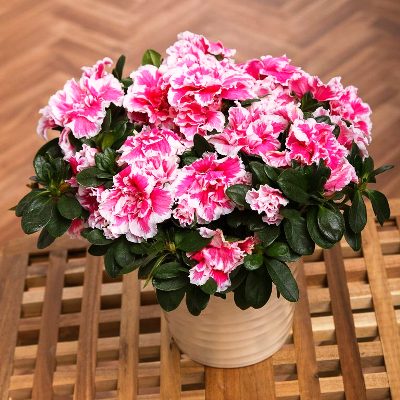

Blooming azalea
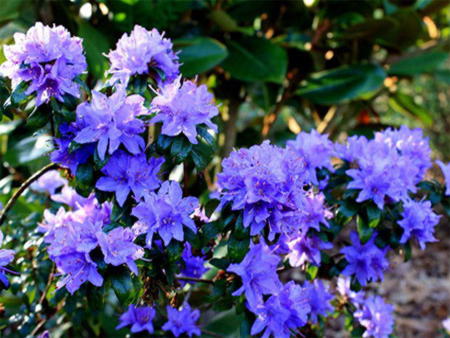

As you already understood, caring for an azalea at home is a delicate matter. How to achieve blooming azaleas? Many people ask themselves this question. If you have created all the conditions for your beauty, then she will not disappoint you. The secret of long flowering and preservation of this shrub at home is, as we already know: timely watering, low temperature and, finally, bright diffused light. In a warm room, the flowering period of the azalea is reduced, and in exceptional cases, the buds may completely fall off. If the ambient temperature is maintained at 12 degrees, the azalea will delight you with its flowering for 2 - 2.5 months. But if the temperature regime of 18-20 degrees is not observed, only 2 weeks.
Azalea during the flowering period is covered with beautiful flowers. Sometimes there are so many of them that you can't even see the leaves. During the flowering period, azaleas can be shaped, carried and rotated. When purchasing an azalea in a flower shop, be guided by the following principle: the plant should have several blossoming flowers, the rest of the flowers should be in the form of unblown buds. With proper care, you will watch the buds bloom and your azalea will transform before your eyes. After flowering, dried inflorescences are removed from the azalea, and a crown is formed.
Types and varieties of azaleas with descriptions and photos
Under natural conditions, there are not so many varieties of azaleas. But thanks to the efforts of flower growers, plants were obtained that differ in different shades of buds.
Important! Indoor azalea grows very slowly, so it will take several years to get a beautiful and lush bush.
The main types are listed below.
Japanese azalea
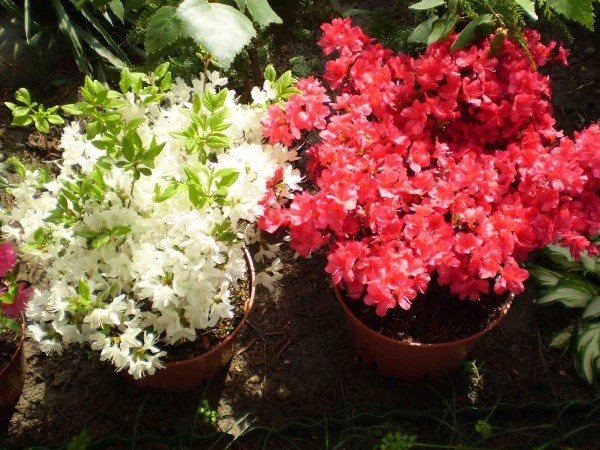

The second name is blunt rhododendron, it is grown in pots. With proper care, the height of the flower reaches 1 meter. The stem is covered with foliage. When opened, the buds acquire a pink or fiery red hue.
Indian or rhododendron sims
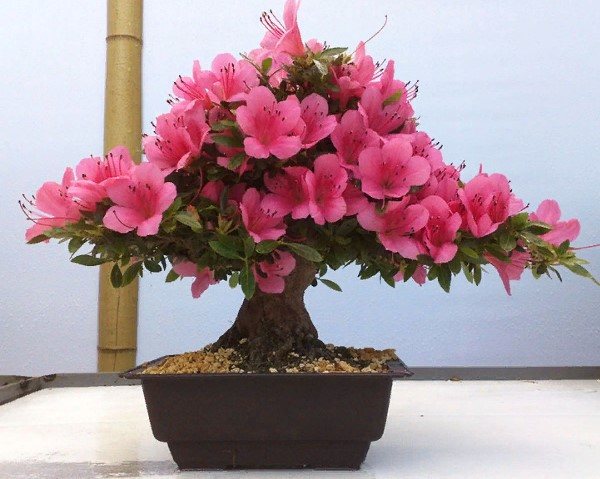

The leaves are elongated, rich green. It grows as a highly branched shrub up to 40 cm in height. There are early varieties that bloom in December. The middle ones are covered with flowers in January, and the later ones form buds at the very end of winter or early spring. The petals are colored in various shades of red, white is found, rarely yellow. The shape of the flowers is simple or double, they are monochromatic or variegated, with strokes or a border.
Nap Hill
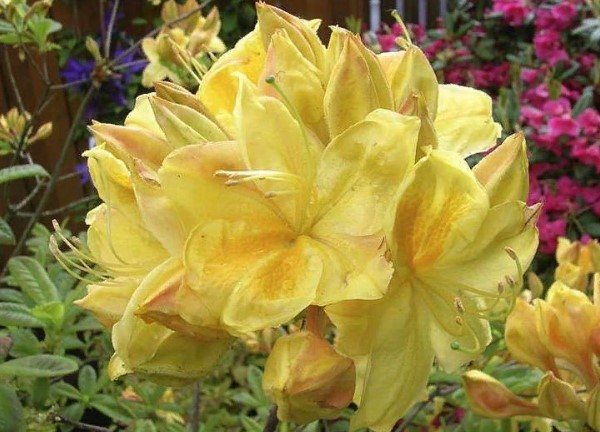

It is a deciduous hybrid shrub that grows up to 2 meters high. Flowers come in a variety of colors: red, pale pink, orange, yellow. They are collected in inflorescences of 8-12 pieces, with a pleasant aroma. The foliage turns reddish or yellow with the onset of autumn. Well tolerates winter.
Proper watering, air temperature and timely feeding are the key to a beautiful plant. If you want the azalea to please with long flowering, it will be enough just to follow the recommendations.
Azalea propagation
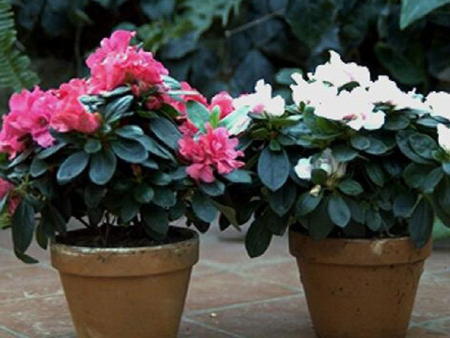

Azaleas are propagated by cuttings. Let's make a reservation right away that this is not for the lazy, there is a long and painstaking work ahead. In the spring we cut the shoots 7-9 cm long, pinched last year in July, after pruning. Cut off the 3 lower leaves, leave the length of the cutting equal to 0.5 cm, cut off the remaining leaves by half. We make an oblique cut from below under the kidney itself. It should not be forgotten that we harvest cuttings only from healthy, well-developed plants and no more than once a year.
Before planting, we tie the cuttings into a bunch of 10-20 pieces.We immerse the prepared bundle in a container with a solution of heteroauxin (indoleacetic acid - a growth stimulator) - (2 tablets per 1 liter of water) with a lower cut for 6 hours. Then we transplant it into a prepared greenhouse to a depth of 2 - 3 cm.At the bottom of the greenhouse we put gravel 2 - 3 cm, then sifted coarse sand (without stones) 3 cm, and on top we fill in the substrate - a mixture of coniferous soil and peat, cover the whole greenhouse with a film, spraying periodically.
We plant cuttings according to the 4x4cm scheme. With a greenhouse temperature of 25 degrees and a relative humidity of 80%, your cuttings will form a strong root system in 2 months. The temperature in the greenhouse must not be allowed below +22 degrees. From time to time you need to turn the greenhouse so that all the plants are illuminated evenly. If possible, install a heating device in the greenhouse with an automatic temperature control system within 25-27 degrees. Azalea propagation by cuttings is possible only from mid-July to mid-October. We ventilate the cuttings a week after planting in the morning for an hour, avoiding drafts, then cover with foil again. As soon as the cuttings give roots and the growth of shoots begins, we remove the film and begin to spray and water our babies daily with thawed, boiled or distilled water so that the soil is moist all the time.
As soon as the young shoots reach two or three centimeters, we transplant the cuttings into pots or a greenhouse filled with coniferous substrate by 10-12 centimeters. According to the scheme 10x10 cm. 2-3 months after transplanting, the tops of the cuttings are pinched to form a bush and young shoots. We remove the first buds from the plant for better growth of new shoots. After 3 months, we pinch a second time and cut off from 4 to 6 new shoots. So we come to the time of transplanting young shoots into new pots filled with substrate. It is better to take a pot size of about 10 cm. The whole process of growing cuttings lasts about 2 - 3 years.
How to grow from seeds?
Some growers decide to get a plant from seed. This is a rather long way, but it is also used periodically. Here's what to do:
- Purchase seeds from a specialty store. You will not be able to get them yourself, because the flower will not pollinate.
- Prepare a container for planting and pour drainage there, as well as the substrate 1–2 cm below the container level.
- Disinfect the soil.
- Spread out the seeds so that there is a distance of about 1.5 cm between them.
- Spray them with a spray bottle.
- Cover the container with plastic, creating ideal conditions.
Important. You do not need to sprinkle them with earth. They themselves will give roots and take root in the ground.
Azalea transplant
Azalea transplant should be done only when absolutely necessary. You can transplant only once a year if the plant is not yet 3 years old, and twice a year if the plant is older. The reason for transplanting an azalea can be a highly overgrown root system, which tightly enveloped the substrate, or decay of the substrate with all kinds of formations on the surface. After buying an azalea from the store, try not to transplant the flower for as long as possible. Give the flower time to adapt to new conditions.
When transplanting azaleas, use a special soil for rhododendrons.
Plant selection
In order for a bush purchased in a store to delight the owner for many years with its luxurious appearance, it is necessary to choose the right flower and take care of its further adaptation. There are a number of factors to consider when buying.
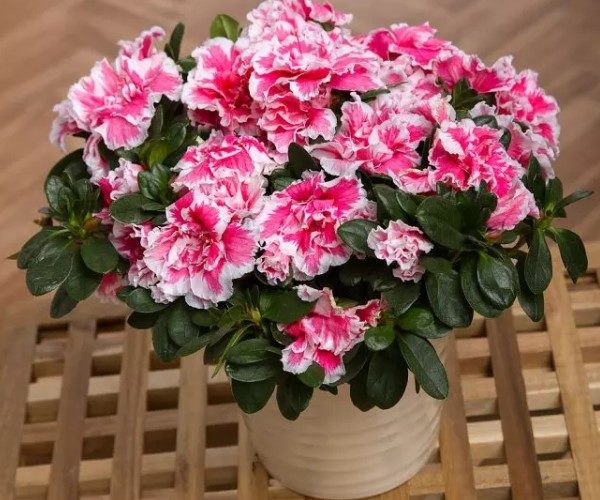

- Pot volume. It should match the size of the bush - not too cramped, but not very spacious either.
- The soil should be moderately moist - not overdried and without stagnant water. Otherwise, there is a risk of acquiring a flower with a damaged root system.
- The surface of the soil must be clean, free from plaque and mold.
- An unpleasant odor should not come from the pot.
- It is better to choose a bush with small light green leaves - large leaves of a rich dark green hue indicate an overfeeding of the plant.
- The back side of the leaves should be examined - there should not be any traces of damage by pests or diseases (spots, cobwebs, insects).
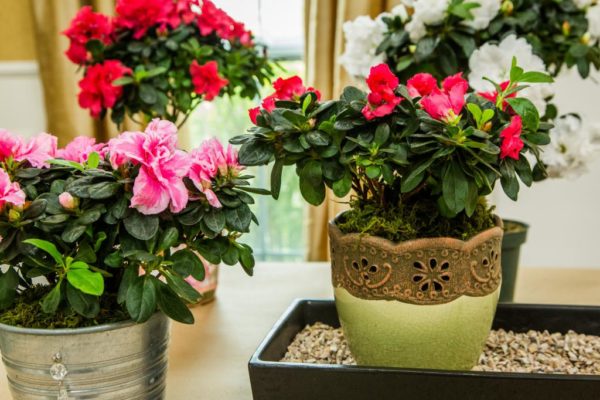

Advice!
It is recommended to purchase already faded or only blooming specimens. Plants that are in the stage of active flowering are more difficult to tolerate the change in their usual environment, and they adapt for a long time and painfully.
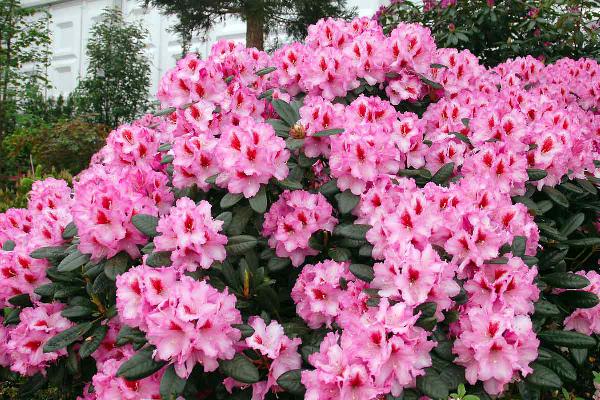

Pruning azalea
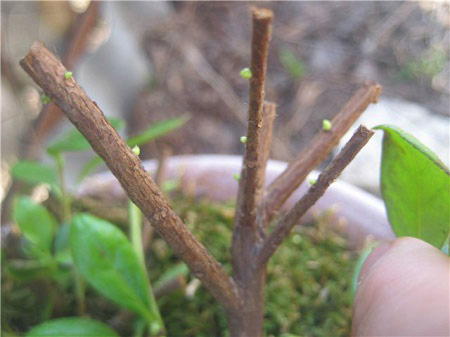

Pruning and pinching plays an important role in caring for azaleas at home. Pinching for azaleas is a must as it increases the flowering intensity. Azalea can only be pruned after flowering, while removing strongly overgrown and weak shoots. To form the crown, young shoots are pinched, and the shoots formed near the flower buds must be removed. New leaves on cut shoots will appear only after 2-3 weeks. If you do not engage in the formation of the crown of the azalea, then over time it will become more and more spreading, with a decrease in the number of flower buds.
Features of varieties
Today there are a large number of azalea varieties. Interestingly, it is absent as a separate species. Biologically, it is a rhododendron. However, due to some historical events, modern flower growers still classify it separately. Despite the huge number of varieties, they all look similar to each other. They differ only in size and flowering.
There are indoor and outdoor varieties. Here are the features of all types of this culture:
- The plant is highly branched, but not tall. Does not exceed one and a half meters.
- Young shoots have a large number of brown or gray hairs.
- Leaves are lanceolate, up to 3 cm in length.
- During flowering, up to six buds appear. They are located practically in the leaf axil.
- Flowering occurs in winter and early spring when favorable conditions are created. The first bloom is four years after planting.
- The stem is dense, treelike.
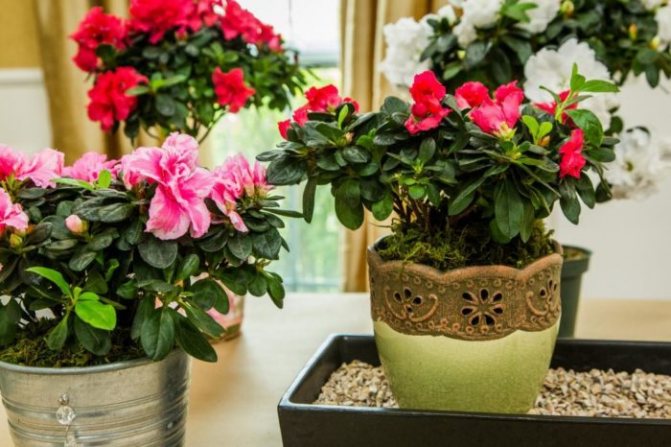

Thus, a plant in indoor conditions can perfectly decorate a windowsill. It is unpretentious, so even inexperienced growers can afford to grow it.
5 / 5 ( 1 voice)
Azalea diseases
All azalea diseases are caused by improper care: non-observance of the temperature regime, improper watering, insufficient lighting, improperly selected fertilizer or soil. You can determine the main diseases of azaleas by the following signs.
- Azalea leaves wilted, turned yellow and fall off along with the buds, which means that the plant suffers from insufficient watering or from an excess of direct sunlight. This can be corrected by observing the rules for watering and spraying. You can read about it here "Watering the azalea".
- Azalea flowers gradually turn yellow, become lethargic and fall off, which means that the quality of your water for irrigation leaves much to be desired. Alternatively, you can try watering the azalea with boiled water with the addition of fertilizers. You can read about it here "Watering the azalea", "Fertilizing the azalea".
- A very common pest that affects the azalea is the "Spider mite". It appears when there is insufficient watering in dry and warm air. A cobweb appears on the stems, the buds begin to turn yellow and fall off. You can fight it by sprinkling the azalea leaves with a mild soapy solution. Then rinse the flower under a warm shower.
- The worst thing that can hit your azalea at home is the strawberry mite. The tick affects shoots, buds, flowers. Young leaves curl inward. Many small buds are formed instead of 1-3 large ones. The growth of the plant slows down, the buds do not open or open, but of a bizarre shape. It is very difficult to defeat him, but it is possible.Alternatively, you can use the Neoron anti-tick agent. Process the plant and dishes only according to the instructions for use.
Pests, diseases and methods of dealing with them
The delicate flower is often attacked by harmful organisms. Among the diseases on azaleas, there are manifestations of powdery mildew, rust, fusarium and other rot, often caused by overflow. To combat such diseases, chemical preparations and transplantation into a new substrate are used.
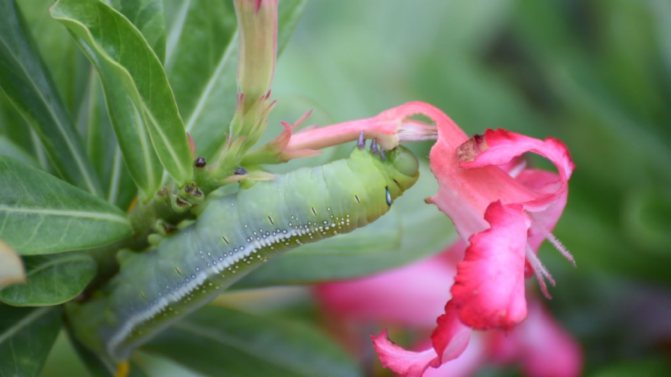

The following pests stand out:
- azalea moth;
- greenhouse whitefly;
- mealybug;
- aphid;
- mite.
When populated by these pests, the crop must be immediately sprayed with an insecticidal preparation according to the manufacturer's instructions.

